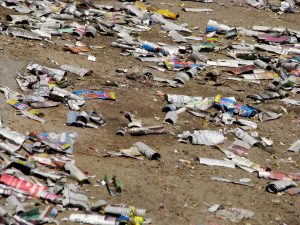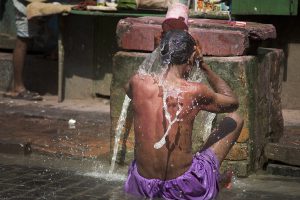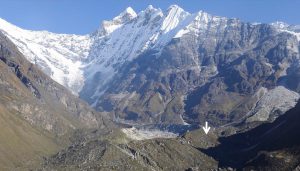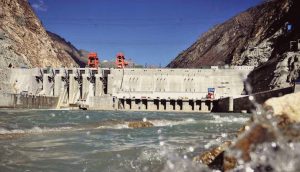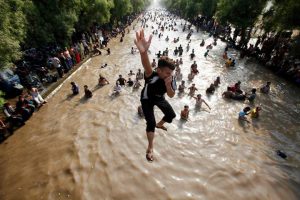Tucked behind towering cliffs and inside deep canyons in a remote corner of Upper Mustang, Samzong appears abandoned from a distance. Houses look deserted and farms look dry. The river alongside the village is down to a trickle.
Enter the village, and it is clear why: there is no water. People line up at the village’s only tap, carrying their empty buckets.
“This is the only water tap working here. The other one went dry a few days ago so everyone has to come here instead,” says Nima Gurung.

In a trans-Himalayan region that receives less than 200 millimetres of rain a year, erratic rain and snowfall have led to a deepening water crisis.
“The rain never arrives on time anymore. When it rains, it rains extremely heavily for a short period but it is not enough to sustain the village,” says Topke Gurung, one of the village chiefs.
Known formerly as the Kingdom of Lo, and open to outsiders only in 1992, Upper Mustang still has an air of mystery around it. Bordering China on the north and situated in the rain shadow of the Himalayas, it is famous for its arid mountains, steep cliffs and dry ochre-coloured landscape. The region is heavily influenced by Tibetan culture, as is evident by the many monasteries, prayer wheels and Chortens (shrines), spread throughout its villages.
In its latest report, the Intergovernmental Panel on Climate Change had said a shortened hydrological cycle was one of the major impacts of climate change. That means fewer rainy or snowfall days, but heavier rain or snowfall in those days. The effect is the same – floods and droughts in the same place. And in a mountain village, floods mean flash floods that kill often.
[iframe src=”https://a.tiles.mapbox.com/v4/nepalitimes.njpob1fb.html?access_token=pk.eyJ1IjoibmVwYWxpdGltZXMiLCJhIjoiTW4teTFNayJ9.mEn3ee2Ie5t3EnqMS3VOIw” width=”100%” height=”600px”]
In Samzong, the level of water in the river is largely dependent on the amount of snowfall which also varies every year. When the rains do come, they fall in huge torrents that trigger landslides on the barren slopes. As a result, they wash away channels that bring irrigation water to the village, leading to a decrease in the productivity of farmlands.

“Thirty years ago, the area opposite this village was all used for farming, now we don’t even have enough water to irrigate the remaining farms,” adds Gurung.
In the nearby village of Yara, it is the same story. Irregular rain and a lack of reliable irrigation systems have affected crops.
“We used to harvest wheat, buckwheat and mustard twice a year. Since there is not enough water now, we just grow wheat once a year. It is still a problem since the fields get dry before it’s time to harvest,” says Karsang Gurung of the Aama Samuha in Yara.
In contrast to Samzong, there are five water taps in Yara. Built by CARE Nepal – a NGO – the pipes are wide, so they are able to bring enough water to the village. But seasonal flooding has rusted the pipes and damaged the canals which bring water to the village. To avoid conflict, Yara has a system in which each household is given a day to irrigate its fields.
With water taps gradually drying up, Samzong residents requested permission from the then king of Mustang to relocate to Namashung in Chhoser village after the flash floods of 1985 and 1987 left the area devastated.
“There was not much use of the barren land after the floods and with donations, we built 18 houses within two years for every single household,” says Lama Ngawang Kunga Bista, who organised the relocation. Only the irrigation channel is left to be built, and it is expected to be completed by 2016.

Residents are happy to move to Namashung, to be closer to provincial Lo Manthang – once the capital of the Kingdom of Lo.
Dheye is another village from which every resident is moving to a new village called Thangchung. Their problem is that only two houses have been built. The rest are still under construction, though the land was allocated a few years ago.
But at least Thangchung is located in an isolated area with ample water supply. That is not case with Namashung. Samzong residents will now be very close to residents of another village, Nenyol. People there are already worrying about having to share the little water and they have. And what if the water gets contaminated, they ask.
“The government must authenticate the process and issue certificates after the residents have moved,” says Ghana Shyam Gurung of WWF Nepal, a native of Upper Mustang.
Much to the dismay of its residents, Yara does not have an alternative location to move to. While the villagers are highly vocal about their discontent with the shortage of water, there has been no plan to shift to another place.
Reasons unknown
Scientists are struggling to downscale climate change effects to small areas, such as Mustang. Today there is not enough evidence to draw a correlation between water stress and climate change in Mustang, long known as Nepal’s most arid region. But local farmers do know that the weather has become more unpredictable, with either too much or too little rain or snow.

“There are three key elements to keep in mind: the intensity of heat, intensity of rainfall and the timing. With higher temperatures, ice is melting faster and the timing of rainfall and snow has been altered. I believe this is the effect of climate change,” says Ghana Shyam Gurung.
With the completion of the road from Beni in western Nepal to Lo Manthang, many more international and domestic tourists have been visiting the area. Such is the allure of Upper Mustang that foreigners are willing to pay a permit fee of $500 for a 10-day visit. This summer, though, has been a poor tourism season, as many foreigners cancelled their trips in the wake of the April 25 earthquake. Many residents of Upper Mustang now depend on tourism to make a living, and are wondering how to make both ends meet this year. The water shortage is not going to help.
[youtube http://www.youtube.com/watch?v=LBPfkPQT0CE&w=640&h=360]
Ayesha Shakya is Online Producer at the Nepali Times. This report was written with the help of a Geojournalism project grant provided by The Third Pole. A version of this article was first published in the Nepali Times.


